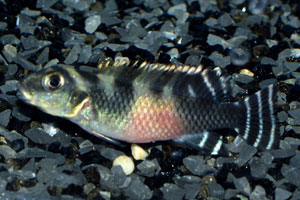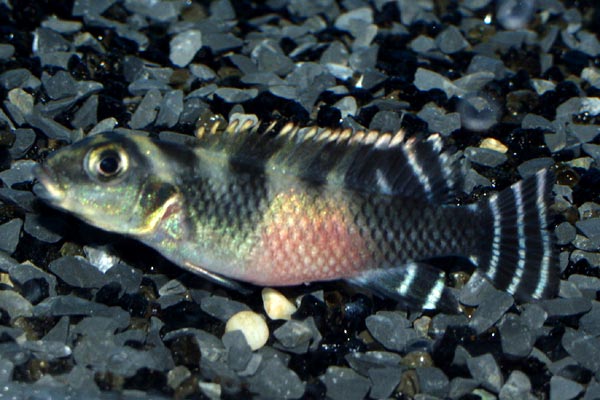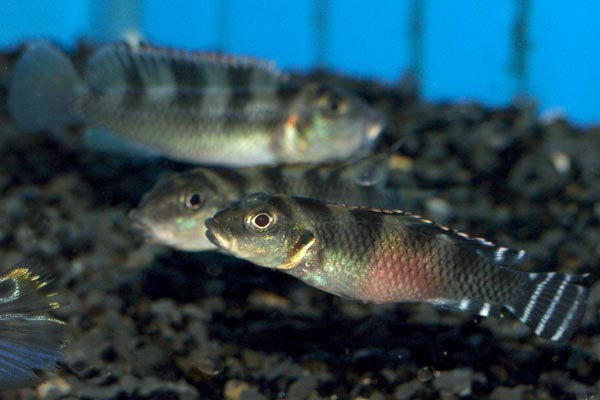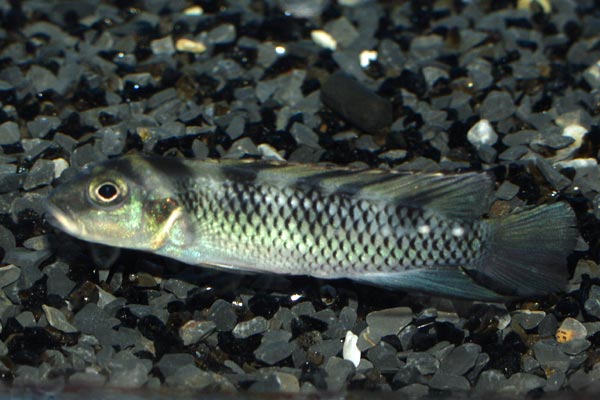

Species Profile | Images | Breeding Report | Similar Species

(Other members of the genus Nanochromis)
ADULT SIZE: 6 cm
WATER CONDITIONS: Very soft and acidic
TEMPERATURE RANGE: 26-29 C
FOOD: Feed Nanochromis transvestitus small live-foods and fine grade dried foods
DISTRIBUTION: This species comes from Congo (DRC)
SEXUAL DIFFERENCES: Males and females of this species are quite different in pattern and colouration. Females are plumper with a red belly and black and white stripey tail. Males lack both of these features.
AQUARIUM CARE: This dwarf cichlid hails from a blackwater lake in the Democratic Republic of Congo, lake Mai-Ndombe. This West African cichlid is small, and brightly coloured, and therefore a good candidate for a species tank, or West African biotope with a few killifish, or African tetras, and planted with Anubias and decorated with bogwood and caves.
BREEDING: Lake Mai-Ndombe is a very acidic lake, (pH 4.2 - 5.5) and aquarium-kept specimins will only breed in equally acidic water, however they will live happily in most soft to medium water conditions. Conditioning well helps induce spawning; feed protein-rich foods such as whiteworms. They are a typical cave spawning species, and good results can be acheived by placing a group together in a larger tank, and letting pairs form.
Have you bred Nanochromis transvestitus? Why not fill in a breeding questionaire?, or examine existing Nanochromis transvestitus breeding reports
Other members of the genus Nanochromis
Other cichlid species
Other species from Congo (DRC)

This image shows the female, with red belly and stripey tail

A male (background) displays to a female in the foreground

Males of the species are less colourful than females - note the lack of red on the belly of this individual
BREEDING: Lake Mai-Ndombe is a very acidic lake, (pH 4.2 - 5.5) and aquarium-kept specimins will only breed in equally acidic water, however they will live happily in most soft to medium water conditions. Conditioning well helps induce spawning; feed protein-rich foods such as whiteworms. They are a typical cave spawning species, and good results can be acheived by placing a group together in a larger tank, and letting pairs form.
Have you bred Nanochromis transvestitus? Why not fill in a breeding questionaire?
This page summarises breeding reports provided by visitors to this site, along with some statistical analysis. Please feel free to contribute - whatever your experience!
| |||||||||
|
| ||||||||
|
| ||||||||
|
| ||||||||
|
| ||||||||
Remember, each record represents only one persons experience; if you had different results, or used different methods, please share your experiences
| Water conditions: Very soft and acidic | Water temperature: 24-27oC |
| Disposition: Very timid | Community tank?: Doubtful, only with VERY calm fish |
| Spawning Method: Other (see below) | Breeding problems: Poor egg production |
| Sex ratio: Roughly equal | Breeding difficulty: Average |
| Sucess: Fairly sucessful | Years Experience: 1 |
| Other Comments: | |
| Date this record created: 31st December 2012 | Breeding date: 2012 |
| Breeder: | Location: Spain |